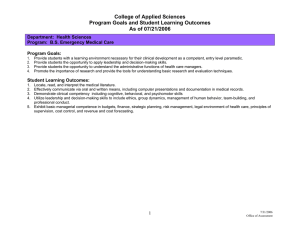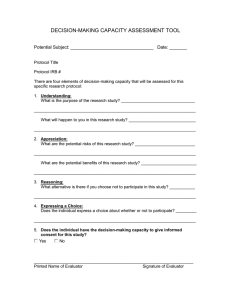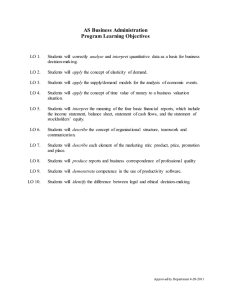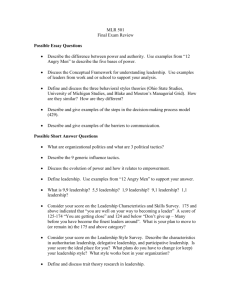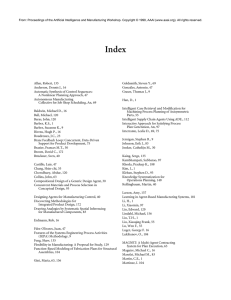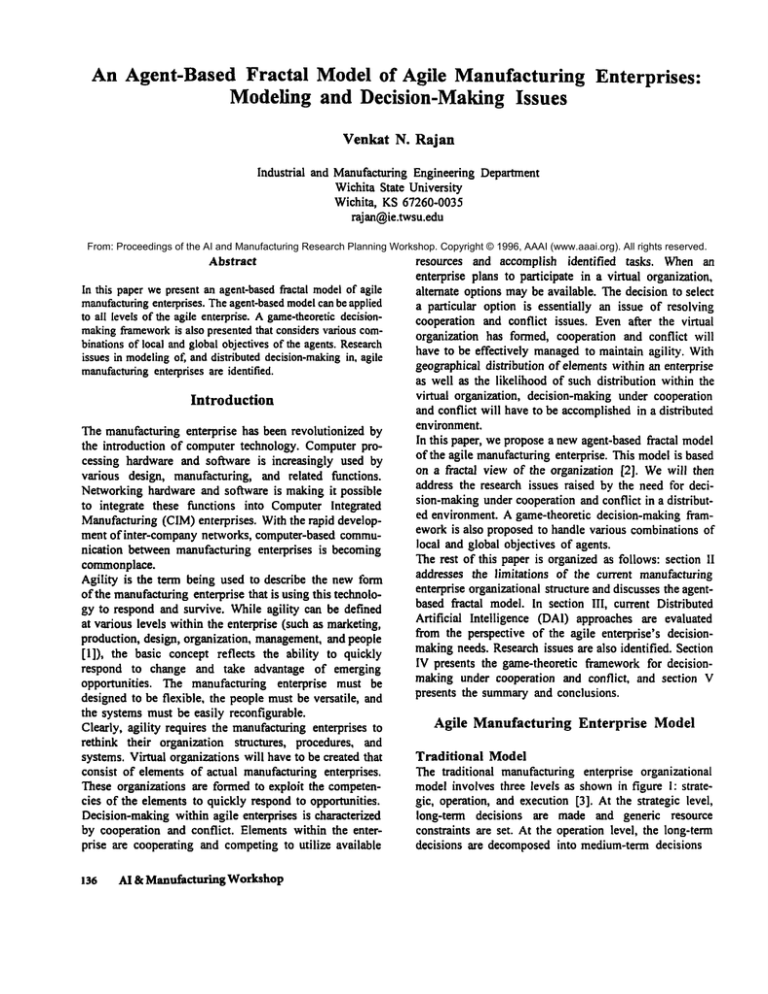
An Agent-Based Fractal Model of Agile Manufacturing Enterprises:
Modeling and Decision-Making Issues
Venkat
Industrial
N. Rajan
and Manufacturing Engineering Department
Wichita State University
Wichita, KS 67260-0035
rajan@ie.twsu.edu
From: Proceedings of the AI and Manufacturing Research Planning Workshop. Copyright © 1996, AAAI (www.aaai.org). All rights reserved.
Abstract
In this paper wepresent an agent-basedfractal modelof agile
manufacturing
enterprises. Theagent-basedmodelcan be applied
to all levels of the agile enterprise. A game-theoreticdecisionmakingframework
is also presentedthat considersvarious combinations of local and global objectives of the agents. Research
issues in modelingof, and distributed decision-making
in, agile
manufacturing
enterprises are identified.
Introduction
The manufacturing enterprise has been revolutionized by
the introduction of computer technology. Computerprocessing hardware and software is increasingly used by
various design, manufacturing, and related functions.
Networking hardware and software is making it possible
to integrate these functions into ComputerIntegrated
Manufacturing(CIM)enterprises. With the rapid development of inter-company networks, computer-based communication between manufacturing enterprises is becoming
commonplace.
Agility is the term being used to describe the new form
of the manufacturingenterprise that is using this technology to respond and survive. While agility can be defined
at various levels within the enterprise (such as marketing,
production, design, organization, management,and people
[1]), the basic concept reflects the ability to quickly
respond to change and take advantage of emerging
opportunities.
The manufacturing enterprise must be
designed to be flexible, the people must be versatile, and
the systems must be easily reconfigurable.
Clearly, agility requires the manufacturingenterprises to
rethink their organization structures, procedures, and
systems. Virtual organizations will have to be created that
consist of elements of actual manufacturing enterprises.
These organizations are formed to exploit the competencies of the elements to quickly respond to opportunities.
Decision-makingwithin agile enterprises is characterized
by cooperation and conflict. Elements within the enterprise are cooperating and competingto utilize available
! 56 AI & Manufacturing Workshop
resources and accomplish identified tasks. Whenan
enterprise plans to participate in a virtual organization,
alternate options maybe available. The decision to select
a particular option is essentially an issue of resolving
cooperation and conflict issues. Even after the virtual
organization has formed, cooperation and conflict will
have to be effectively managedto maintain agility. With
geographical distribution of elements within an enterprise
as well as the likelihood of such distribution within the
virtual organization, decision-making under cooperation
and conflict will have to be accomplishedin a distributed
environment.
In this paper, we propose a new agent-based ffactai model
of the agile manufacturingenterprise. This modelis based
on a fractal view of the organization [2]. Wewill then
address the research issues raised by the need for decision-makingunder cooperation and conflict in a distributed environment. A game-theoretic decision-making framework is also proposed to handle various combinations of
local and global objectives of agents.
The rest of this paper is organized as follows: section II
addresses the limitations of tbe current manufacturing
enterprise organizational structure and discusses the agentbased ffactal model. In section III, current Distributed
Artificial Intelligence (DAI) approaches are evaluated
from the perspective of the agile enterprise’s decisionmakingneeds. Research issues are also identified. Section
IV presents the game-theoretic frameworkfor decisionmaking under cooperation and conflict, and section V
presents the summaryand conclusions.
Agile
Manufacturing
Enterprise
Model
Traditional
Model
The traditional manufacturing enterprise organizational
modelinvolves three levels as shownin figure i: strategic, operation, and execution [3]. At the strategic level,
long-term decisions are made and generic resource
constraints are set. At the operation level, the long-term
decisions are decomposedinto medium-termdecisions
From: Proceedings of the AI and Manufacturing Research Planning Workshop. Copyright © 1996, AAAI (www.aaai.org). All rights reserved.
I
........
.=
.°,
i
Orgamzational
Technical
Long-range
Planning
Forecasting
Product
fine
[anufacturing
system
Personnel
Finances
Engineering
and Design
Design
Development
Engineering
documents
Development
Performance
testimz
Production
Scheduling
Orderprocessing
Resources
scheduling
Timephasing
Costaccounting
Process & QC
Production
Control
Loadbalancing
Ovemme
planning
Operations
sequencing
Manufacturing
Assembly
Machine
control
Materials
flow
control
Tooltlow
control
Storage
control
~larketing
and’
J.!quality.
assurance
Marketing
Salesstrategy
Product
strategy
Market
survey
Market
analysis
Product
design
b.
i
Planning
Processplanning
Pans
programming
QCplanning
Quality
Assurance
Customer
complaints
Product
histo~"
Statistical
evaluation
QualityControl
Testing
Evaluating
FigureI: TraditionalManufacturing
EnterpriseOrganizational
Model[3].
andthe constraints specifications are refined. At the
execution level, the short-termdecisions are madeand
executedin conformance
with the operationlevel decisions andconstraints.
For a specific example,consider the organizational
columnof figure 1, whichrepresentsthe manufacturing
planningandcontrol(MPC)
activities. Thestrategic level
activity is aggregateor long-rangeplanningin whichthe
long-termdemand
forecastsandenterprisestrategic objectives are usedto determine
production
strategies andset
resourceconstraints.At the operationlevel, the aggregate
plan is decomposed
into the masterproductionschedule
(MPS),whichcombinesthe forecasts with actual customer demandsto determine medium-term
production
schedulesfor end products, andMaterialRequirements
Planning (MRP),whichprovides detailed production
schedules for subassembliesand components.At the
executionlevel, the production
ordersare releasedto the
shop floor and executed to producethe components,
subassemblies,andendproducts
tOmeetcustomer
needs.
In sucha structure,decision-making
is rigidly defined.
Little or noattentionis paidto the interestsof participating entities suchas departments,
machines,or people.
Changeis difficult andexpensive to accomplish,and
problemsarise due to poor management
of resources.
Manyof the elementsof agility, such as a systemdesignedto be flexible, andreconfigurabilityof the system
are lost due to these rigid procedures.Optimization
procedures
are also difficult to implement
andtheir effect
is generallylocal.
Agent-based Fractal Architecture
In orderto maintainagility of the manufacturing
enterprise, weproposean agent-basedfractal modelas shown
in figure2. Eachlevel of the decision-making
structureis
Rajah
137
From: Proceedings of the AI and Manufacturing Research Planning Workshop. Copyright © 1996, AAAI (www.aaai.org). All rights reserved.
AGILE
ENTERPRISE
AGENT
4
AGENT
AGENT
INTERNAL
INTERFACE
J
J AGEN’
L
AGENT
.....
I A~ENT
I
~ERNAL
L’NTE"F*C"
]
F AGENT
,
--,--
~i--AGEN~
Figure 2: Agent-BasedFractal Modelof the Agile Manufacturing Enterprise.
composedof interacting agents. Cooperation and conflict
betweenagents is resolved to obtain decisions. Decisions
are propagated from one level to the next by means of
clearly defined interfaces. Decisions from higher levels
are communicatedto agent organizations at lower levels
in a top-down model of decision-making. The status of
each level is communicatedback to the next higher level
across the interface to provide feedback for decisionmaking.
A fractal view [2] of the decision-making structure is
obtained by considering the fact that each level of the
structure is an organization of agents, as shownin figure
2. In a function-based organization, at the highest levels,
the various departments such as marketing, engineering,
manufacturing, accounting, etc., wouldeach be considered
an agent. The strategic decision-making is accomplished
by these agents and those at levels above them. The
subfunctions within each department would form an
138
AI & Manufacturing Workshop
organization of agents. For example, planning, manufacturing engineering, fabrication, and assembly wouldbe
the agent organization under the manufacturing department. The operation-level interaction betweenthese agents
would accomplish production of end-products. The people
and associated systems wouldbe considered agents at the
next level. This concept is similar to that proposed by
Frost and Cutkosky [4]. For example, in the design
environment, the designer and the associated design
system wouldbe treated as an agent. In the manufacturing
domain, machines and operators would represent agents.
As the decompositionoccurs, at the lowest levels of the
structure, constraints and parameterscan be represented as
agents. For example, design for manufacture and assembly
(DFMA)rules could be modeled as agents, and their
interactions evaluated to modify the design. Manufacturing process parameters could be represented as agents and
the characteristics of the fabricated componentcould be
viewed as the result of the interactions between the
accomplish, and requires certain resources to accomplish
From: Proceedings
© 1996,
AAAI minimum,
(www.aaai.org).
All rights
parameter
agents. of the AI and Manufacturing Research Planning Workshop.
theseCopyright
tasks. At
the very
contention
forreserved.
resourcThus, the fractal view is expressed by the fact that as one
es represents conflict interactions. As mentionedearlier,
conflicts between design rules and process parameters can
explores deeper and deeper within the structure the same
also occur. Cooperation interactions occur due to the
agent pattern and decision-making structure is repeated.
global objective of agent organizations to successfully
The decision-makingstructure is characterized by cooperation and conflict between agents at any given level. A
accomplish a set of tasks, to meet a constraint specified
plug-and-play architecture is also accomplisheddue to the
by a higher-level organization, or to operate using the
feedback obtained from a lower-level organization. The
characteristic of multiple agents makingdecisions under
cooperation and conflict. Therefore, a generic modelof a
nature and relative importance of local and global objecmulti-agent system can be developed, and the implementives may change from one level to the next. As mentation at each level of the organization architecture can be
tioned earlier, the inputs, outputs, and operating knowledge change from one level to the next.
accomplished by creating instances of system variables.
Whyis the agent-based fractal modelbetter suited to the
Such a generic model is shown in figure 3, with the
agile manufacturing enterprise? As discussed earlier,
feedback interface to the next higher level, and the
agility is the ability to respond to change. The agentdecision-communicationinterface to the next lower level.
An external interface also exists as shownin figure 3, to
based fractal architecture provides the ability to explicitly
allow the agent organization at any given level to interact
represent the entities and processes within the enterprise.
The competencies of the enterprise elements are encapsuwith organizations in other enterprises thus facilitating
lated within each agent organization. Reconfiguration of
virtual organizations.
Cooperation and conflict interactions at any level of the
the enterprise is facilitated by the modularrepresentation
and separation of internal and external processes. By
enterprise organization arise due to local and global
objectives of agents. Eachagent has certain tasks it has to
redefining the global and local objectives, their relative
FI : FEEDBACKINTERFACE
El : EXTERNALINTERFACE
DCI : DECISION COMMUNICATIONINTERFACE
Figure 3: Generic Agent-BasedModelthat Facilitates
a Plug-and-Play Architecture.
Rajah
139
importance, and the domainknowledgerepresenting the
agent and interface representations and hierarchies. The
messagepassing capability is being used to facilitate
decision-making.
From:
Proceedings
of the AIthe
and internal
Manufacturing
Research
Workshop. Copyright © 1996, AAAI (www.aaai.org). All rights reserved.
element
competency,
processes
canPlanning
be quickly
and easily reconfigured. Byappropriately modifyingthe
external interface along with the internal feedbackand
decision-communication
interfaces, virtual organizations
can be created and modified. Also, by maintaining
internal interfaces with an enterprise element that is
participating in a virtual organization,appropriatecontrol
can be maintained over the element from within the
enterprise. Informationhiding to protect the proprietary
nature of some knowledgecan also been accomplished
becauseof the separation betweenthe external interface
and the internal knowledgeof an agent organization. As
entities andprocessesare createdor eliminatedwithinthe
manufacturing enterprise, the existing model can be
updatedby creating or deleting agent organizations. As
mentionedearlier, the agent-based fractal modelhas a
plug-and-play feature that allow for developmentof
generic agent organizations whichare then instanced at
various levels within the enterprise. Whileoptimization
procedures can be implementedwithin the decisionmakingprocessof the individual agent organizations, the
results maystill be local. If the interfaces are properly
designed,it maybe possible to evaluate the global impact
of local decisionsquickly.
A decision-makingapproachthat supports the agent-based
fractal model specified in the previous section must
possessthe followingcharacteristics:
1. It should take into account both global and local
objectives,i.e., cooperationandconflict interactions,
simultaneously. It must be possible to modeland
analyze multi-agent systems that operate under
purely global, purely local, or any combinationof
local andglobal objectives.
2. It must be possible to predict the behavior of the
multi-agentsystemgiven the local and global objectives andtheir relative importance.Thus,the system
designer can either manipulatethese objectives to
obtain a particular behavior,or modelexisting objectives andpredict the behavior.
3. It mustbe possibleto abstract froma particular agent
organization implementationto perform decisionmaking.Whilethis is not directly an issue related to
the decision-making
approach,it is importantthat the
decision-making
approachuse an abstract representation of the data to arrive at decisions.Thisallowsus
to developa generic decision-makingmodelthat can
be implementedin a plug-and-playfashion.
Variousresearchissues related to the agent-basedfractal
modelare currently being addressed[5]. Theseinclude a
game-theoreticdecision-makingapproach, agent models,
and interface specifications. Anobject-oriented approach
is being adoptedin whichthe abstraction, encapsulation,
and inheritance capabilities are being exploitedto model
140
AI & Manufacturing Workshop
Multi-Agent
Decision-Making
Under Cooperation and Conflict
Variousresearchers havestudied the issue of distributed
decision-making
withinthe DistributedArtificial Intelligence (DAI)domain.Oneof the earliest efforts involved
the development
of the Contract-Netprotocol [6] in which
a bidding approachis used to allow agents to cooperatively solve problems.This approachhas beenapplied in
the manufacturing
domain,mainlyto create opportunistic
shop-floor scheduling systems [7,8]. Another major
research effort involves the developmentof and experimentation with the Distributed Vehicle Monitoring
Testhed (DVMT)
[9,10]. In the DVMT
implementation,
agents monitoringregions are required to cooperate to
create global mapsof vehicle trajectories. Weare not
awareof any direct manufacturingapplications of this
research.
Gametheory has beenused [1 I] to study cooperationand
conflict within agent organizations.Theprimaryemphasis
has beenon definingvarious types of rationality to allow
decision-making. The communicationneeds to allow
agents to convergeto a single plan are also discussed.In
our previous research [12,13,14], wehave explored the
application of gametheory to multi-machine
cooperation.
It is shownthat cooperative gametheory concepts are
useful to accomplish cooperation in multi-machine
systems,however,detailed studies havenot beenconducted. Other approacheshaveincluded resolving conflicts
betweenindividual agent plans to create a global plan
[15,16], and studies of negotiation protocols to allow
agents to convergeto a single plan [17].
There have been a few applications of DAImulti-agent
concepts to manufacturing related problems. As mentioned above, the contract-net protocol has beenapplied
to the factory control problem[7]. Adistributed scheduling approachhas also beendevelopedusing a multi-agent
approachin whichpartial plans generatedby agents are
combinedto obtain an overall productionschedule [18].
Other applications include developmentof multi-agent
architecturesfor collaborativedesign[19], for interaction
betweendesigners and manufacturingprocess information
sources [4], and production control [20]. Somerecent
research efforts haveattemptedto developan architecture
for Distributed CIM[21], concurrent engineering[22],
and enterprise information support [23]. The latter
approachis particularlyinteresting becauseof the integration of DAIand object-orientation concepts. Some
attempts have also been madeto apply DAIconcepts to
robot task planning activities [24,25].
methodologyis lacking.
From:
of the AI and Manufacturing
Planning Workshop.
Copyright
© 1996,DAI
AAAImodels
(www.aaai.org).
All rights
Most
ofProceedings
the DAImanufacturing
applicationsResearch
are limited
3. Would
different
be suitable
for reserved.
different
in their scope [4,7,18,19,20,22] or lack a formal basis
levels of the agile manufacturingenterprise?
[21,23]. The lack of a formal basis prevents abstract
4. Whatare local and global objectives at various levels
evaluation of parameters and mathematical characterizaof the enterprise and what is their relative importion of system behavior. Most of the manufacturing
tance?
applications also implicitly assume the existence of a
5. Whatwould be the differences between the decisionpurely global objective [18,20].
makingmodels for different types of manufacturing
So, which of the existing DAI approaches should we
industries?
6. What are the computation and communication loads
apply to the agent-based fractal enterprise model?Most of
the current DAIapproaches implicitly or explicitly
for various decision-makingtheories and architectures
assumethe existence of only a global objective [6,9]. The
(distributed vs. centralized)?
game-theoretic approaches [11,12,14] have the potential
7. Develop benchmarking problems on which various
enterprise architectures as well as decision-making
to handle any combinationof local and global objectives,
howeverlittle research exists on this issue. Gametheory
approaches can be tested.
generally considers only the local objectives of the agents.
8. Whatis the frequency of decision-making at various
However, in our prior work [14], we have shown that in
levels of the enterprise? Is the decision-making
cooperative gametheory, by controlling coalition formaenvironment monotonic or non-monotonic?
tion and the characteristic function of the game, global
9. What is a good methodologyfor modeling agents and
objectives can be imposed.
interfaces? Webelieve that an object-oriented methIn order to predict the behavior of a multi-agent organizaodology provides the ability to accomplish the
informationhiding, abstraction, hierarchical relations,
tion, given the local and global objectives, a formal
and communicationneeds of the agent-based fractal
mathematical basis is required. Such a basis is also
essential for decision-makingusing an abstract representamodel.
tion of data. Most of the DAIapproaches lack a formal
10. What are standard protocols for communicating
basis. They have evolved by logical analysis of cooperinformationand decisions? If virtual organizations are
ative behavior or by empirical study. The game-theoretic
to form, data and decisions will have to be transferred betweenagent systems from different vendors.
approaches possess the extensive mathematical basis as
well as the abstract problem and data representation. The
Currently, standards for information representation
information regarding the interactions between agents is
are available only for the CADsystems (IGES,
generally modeledin the characteristic function form [26]
STEP) and the newer standards (STEP) capture
as the number of agents increases. Such an abstract
information about the product life-cycle. Howcan the
decisions and information at higher levels be stanrepresentation allows us to study the nature of cooperation
and predict the behavior of multi-agent systems without
dardized?
11.
Whatis the effect of incomplete end incorrect inforconsidering the details of the implementation.
While we have outlined some promising approaches to
mation on the decision-making approach7
decision-making in the agile manufacturing enterprise,
these approaches still need to be validated by detailed
Game-Theoretic
Decision-Making
Approach
analysis. Manyother important DAIresearch issues also
exist that need to be addressed before successful impleN-person Game Theory Concepts
mentations can be developed. Someof these issues are
N-person game theory addresses situations of partial
listed below:
conflict of interest with the followingattributes [26]:
I. Are there formal modelsof multi-agent interactions?
1. Three or more players participate in the game(n >_
Whatis their relevance to manufacturing enterprises
3),
and systems? Webelieve that game theory provides
2. Players can openly communicatewith each other, and
such a formal approach and that it is relevant to
decision-making in agile manufacturing enterprises.
3. Only one player wins a game (zero-sum) or players
Are there other models and are they relevant?
can form subsets, called coalitions, by freely negoti2. Is there a unified methodologyfor analyzing cooperating binding agreements on bow to divide the
ation and conflict interactions that arise underdifferbenefits accrued by acting jointly.
ent combinations of global and local objectives
A game can be represented in three ways depending on
(purely global, purely local, and any combination)?
the level of abstraction used [27]:
Again, we believe that game theory provides us with
1. Extensive form: In this form, the movesof the playthis capability. However,detailed developmentof the
Rajah 141
ers are represented in all possible orders in which
they can be executed. This results in a game tree.
The payoff to each player corresponding to each outcome of the game is known. The analysis is aimed at
identifying the set of movesthat will be most beneficial for each player given the knowledgeof all the
movesthat can be executed by the other players.
2. Normalor strategic form: Instead of dealing explicitly with the moves, the strategies available to each
player and the corresponding outcomesare represented. A solution method then has to find the best
strategy for each player such that the corresponding
payoff is maximized.
3. Characteristic function form: In this form, the payoffs for each subset of players is represented in
function format, without specifying the actual strategies used to obtain those payoffs. This level of
abstraction allows for an analysis of the trade-offs
involved in selecting one solution over another.
The n-person non-cooperative game is analyzed in the
normal or strategic form. In such a game, each player is
looking to maximizehis/her payoff while acting independently. It has been shown that such a game has an
equilibrium solution defined as the Nash equilibrium. The
Nash equilibrium solution exists when players consider
both deterministic strategies (pure) and their probabilistic
combinations (mixed) [28].
The n-person cooperative game is generally modeled in
the characteristic function form [27]. The characteristic
function represents the benefits obtained by an individual
or group of players. Thus, it is also referred to as the
value function [26]. Formally, the characteristic function
v is defined over the set of players n as a real-valued
function that assigns a real numberv(s) to each set
players s, s c_ n. In an esaential game,the value accrued
by a set of players s, s c_ n, is at least as large as the sum
of values obtained by any two subsets of s, i.e.,
less than what they would obtain as the result of
forminga coalition, i.e., ~,, xi >- v(s), for all s, s
From: Proceedings of the AI and Manufacturing Research Planning Workshop. Copyright © 1996, AAAI (www.aaai.org). All rights reserved.
v(s) > v(a) + v(b), for all a, b, wherea, b c_
The objective of cooperative game theory is to determine
the payoffs to each player participating in the game. The
payoffs are represented by a payoff vector, X-- (xm, xz .....
x,). It is assumedthat players behave"rationally". Rationality can be of two forms [27]:
1. Individual rationality: Each player is expected to
behave rationally, i.e., each player is expected to
prefer any payoff vector Xthat give him/her a higher
payoff than if he/she had acted alone, i.e., x, > v(i)
for all i, i ¯ n.
2. Grouprationality: In certain situations, this condition
is imposed where it is expected that no subset of
players will accept a payoff vector Xthat gives them
142
AI & Manufacturing Workshop
n.
A gameis said to be constant-sum if
There are a variety of solutions defined for an n-person
cooperative game depending on the assumptions of individual and/or group rationality. These are the core, the
stable sets, the Shapley value, the bargaining set, and the
kernel [27]. Wewill specifically discuss the Shapley value
and the kernel solution concepts and their implications.
The Shapley value [26] is a payoff vector that represents
the expected payoffs to each player participating in the
game under the assumptions of individual and group
rationality. The Shapley value is a unique solution that
has equity built into it. It is implicitly assumedthat the
grand coalition is formedand this solution describes the
way in which the value of the gameto the grand coalition
is divided amongthe players, if smaller coalitions are
desired, then the group rationality assumptionneeds to be
eliminated altogether. This is the basis for the kernel
solution concept discussed below.
Acoalition structure S -- {s1, s: ..... sin} is a partition of
the set of players n, such that
sj~O
si n sj = Ofor all i, j =1, 2 .....
m, i ~ j, and
%sj=n
An individually rational payoff configuration (irpc)
defined as the combination of a payoff vector and coalition structure, i.e., (X,S), satisfying the conditions
individual rationality and
Y-i~,jxi = v(sj)
The kernel is an equilibrium solution that is defined as the
set of individually rational payoff configurations such that
every pair of players in any coalition in the coalition
structure are in equilibrium with respect to the specified
payoff vector. Equilibrium is defined as the situation
where neither player can obtain a larger payoff by
forming a new coalition in which the other player is
excluded.
In the above solution methods, either the grand coalition
forms, or a coalition structure forms in which each
coalition obtains at least as muchas the value of the
game,i.e., a sense of equilibrium is maintained.
Agile Enterprise
Decision-making Approach
The general decision-making problem at any level of the
agile manufacturing enterprise that we wish to address is
solution are that it requires very few computations, the
From:
Proceedings
of the AI and Manufacturing Research Planning Workshop.
Copyright
© 1996, solutions
AAAI (www.aaai.org).
All and
rightsit reserved.
formulated
as follows:
number
of alternate
are limited,
represents
"A set of tasks need to be accomplished by a set of
agents. A task is defined by the inputs and domainknowledge of the agent organization. Decisions need to be
made in a consistent manner taking into account the
objectives of the agents and the current state of knowledge."
Wepropose to view the multi-agent decision-making
problem from the perspective of various levels of local
and global objectives. Thus, three different situations may
arise [14]:
1. Purely global objective: In this case the agents
cooperate to perform the tasks such that only the
global objective function is optimized. Wewill refer
to this as the coordination problem.
2. Purely local objective: Wheneach agent is attempting to perform its assigned tasks such that its local
objective is optimized, and no global objective has
beenspecified, then this situation exists. In this case,
purely conflict interactions exist betweenthe agents.
Wewill refer to this as the conflict problem.
3. Combination of local and global objectives: When
both local and global objectives exist, the interactions between the agents have to be resolved such
that the combination of the local and global objectives are optimized. Wewill refer to this as the
coalition problem.
Gametheory provides a unified frameworkto handle all
the three situations. The coordination problemis basically
one of formation of the grand coalition. The Shapley
value concept can be used for decision-making under this
mode.As mentionedearlier, the Shapley value represents
an equity solution and is therefore attractive from the
concept of a benevolent situation where agents are not in
conflict with each other [11]. However,the game-theoretic approach does not consider any global objective function. Therefore, this function has to be built into the
characteristic function. One approach, is by defining a
non-zero value for only those coalitions that accomplish
all the identified tasks. Suchcoalitions are called feasible
coalitions. Anycoalition structure that does not provide
an agent or set of agents to perform one or more of the
tasks will be given a value of 0, and therefore ignored in
the computation [13,14].
The conflict situation is similar to the assumptionsof the
n-person zero-sum game, and therefore, the Nash equilibrium solution concept can be used to resolve the conflicts.
The coalition problem is similar to the game-theoretic
concept ofdeterraining which coalition structure will form
given the assumption of only individual rationality. The
game-theoretic solution concept of the kernel is applicable
to the coalition problem. The advantages of the kernel
a set of equilibrium solutions [26].
The unifying characteristic of game-theoretic analysis for
the decision-making problem arises in the common
definition of the characteristic function required by the
coordination and coalition problems. In order to use the
above concepts, the characteristic function needs to be
defined. For the conflict problem, the Nash equilibrium
solution requires the normal (or strategic) form of the
game.
In general, each agent will be aware of all possible
actions that can be taken. Whencombinations of the
actions by different agents are considered, the extensive
form of the game will result. The normal form is a
summaryof the combinations without reference to the
actual actions that are possible. The normalform can then
be converted to the characteristic function form in which
only the payoffs are listed against the possible coalitions
that can form. Therefore, the input information to each
agent organization will have to be converted using the
domain knowledgeinto the possible strategies for each
agent. This is sufficient to perform the Nashequilibrium
analysis for the conflict problem. However, for the
coordination and coalition problems, the normal form will
have to be further abstracted into the characteristic
function form to compute the Shapley value and kernel
solutions. In order to accomplish the implementation of
these solutions, the strategies and payoff configurations
will have to be converted back into actions that the agents
can execute.
The game-theoretic solutions concepts presented above
can easily be computedin a centralized decision-making
architecture. However,in the agent-based fractal model
specified above for the agile enterprise, the decisionmakingwithin each agent organization will be distributed.
The solution approaches will have to be extended to
arrive at the centralized solution using a distributed
decision-makingarchitecture. Issues of static and dynamic
knowledgerepresentation, monotonicity, and convergence
become problems under such an architecture.
Some
research issues related to the game-theoretic decisionmaking approach are as follows:
I. How can the inputs and domain knowledge be
converted into agent actions and strategies? Howcan
the payoff vectors and the characteristic function
form of the game be derived?
2. Is there a distributed decision-making methodology
that can reach the solution generated by the centralized approach? Is it guaranteed to converge to a
single solution?
3. How can the static and dynamic knowledge be
represented in agent models? Is the dynamicknowl-
Rajan
143
edge non=monotonic? How does this
affect
the
Software for Agile Manufacturing. Boston, MA.
as a
Metaphorfor Distributed ProblemSolving. Artificial
Intelligence 20:63-109.
7. Van Dyke Parunak, H. 1987. Manufacturing Experience with the Contract Net. In Distributed Artificial
Intelligence,
M. N. Huhns, ed. Los Altos, CA:
Morgan Kanfman.
8. Shaw, M. J., and Whinston, A. B. 1987. A Distributed Knowledge-BasedApproach to Flexible Automation: The Contract-Net Framework, BEBRFacul~"
Working Paper No. 1384, College of Comm.and
Bus. Admin.,Univ. of III.
9. Durfee, E. H., Lesser, V. R., and Corkill, D. D. 1987.
Coherent Cooperation AmongCommunicating Problem Solvers. IEEE Transactions on Computers.
36:1275-1291.
10. Durfee, E. H., and Lesser, V. R. 1987. Using Partial
Global Plans to Coordinate Distributed Problem
Solvers. Proceedings of the 1987 International Joint
Conferenceon Artificial Intelligence. 875-883.
1 !. Rosenschein, J. S. 1985. Rational Interaction: Cooperation AmongIntelligent Agents. Ph.D. diss., Stanford Univ.
12. Rajan, V. N., and Nof, S. Y. 1990. A Game-theoretic
Approachfor Co-operation Control in Multi-machine
Workstations. International Journal of Computer
Integrated Manufacturing. 3:47-59.
13. Rajah, V. N., and Nof, S. Y. 1992. Logic and Communication Issues in Cooperation Planning for Multimachine Workstations. International Journal of
Systems Automation: Research and Applications.
2:193-212.
14. Rajan, V. N. 1993. Cooperation Requirement Planning for Multi-Robot Assembly Cells. Ph.D. diss.
Sch. of Industrial Engineering, Purdue University.
15. Georgeff, M. A. 1986. The Representation of Events
in MultiAgent Domains. Proceedings of the Fifth
National Conferenceon Artificial Intelligence. 70-75.
16. Georgeff, M. A. 1983. Communicationand Interaction in MultiAgent Planning. Proceedings of the
Second National Conference on Artificial Intelligence. 125-129. Washington, D.C.
17. Conry, S. E., Meyer, R. A., and Pope, R. P. 1989.
Mechanismsfor Assessing Nonlocal Impact of Local
Decisions in Distributed Planning. In Distributed
Artificial Intelligence, VolumeII, L. Gasser and M.
N. Huhns. eds. San Mateo, CA: Morgan Kaufman.
18. Sycara, K. P., Roth, S. F., Sadeh, N., and Fox, M.
1991. Resource Allocation in Distributed Factory
Scheduling. IEEEExpert. 6:29-40.
19. Bond, A. H. 1989. The Cooperation of Experts in
EngineeringDesign. In Distributed Artificial Intelli-
From: Proceedings
of the AI and
Manufacturing Research Planning Workshop.6.
Copyright
© 1996,
AAAISmith,
(www.aaai.org).
All rights
reserved.
decision-making
process?
Davis,
R., and
R. G. 1983.
Negotiation
.
What are the communicationneeds of the different
game-theoretic approaches7
Summaryand Conclusions
Manufacturing enterprises are moving towards an agile
environment in which distributed decision-making under
cooperation and conflict will be essential. Wehave
presented a new agent-based modelof the enterprise that
can be applied to all levels of the organization. The new
model allows us to develop a fractal view of the enterprise because the same agent pattern can be seen from the
highest to the lowest levels.
While many Distributed Artificial Intelligence (DAI)
approaches have been developed, most of them lack a
formal basis and lack consideration of various combinations of local and global objectives that is essential in an
agile enterprise. It has been shownthat the game-theoretic
approach provides a unified theory for situations involving purely global (coordination), purely local (conflict), or
a combinationof local and global (coalition) objectives.
This is important because different situations mayoccur
at different levels of the enterprise and a unified theory
allows us to develop a decision-making frameworkthat is
independent of the particular implementation.
Manyopen research issues have been identified both in
modeling of agile manufacturing enterprises and in DAI
decision-making approaches. By providing solutions to
these problems and developing benchmark cases, the
benefits of applying DAIconcepts to agile manufacturing
enterprises can be realized in the future.
References
!.
2.
3.
4.
5.
144
Goldman,S. L., R. N. Nagel, and K. Preiss. 1995.
Agile Competitors and Virtual Organizations. Van
Nostrand Reinhold.
Wamecke,H.-J., and Hueser, M. 1993. The Fractal
Company - A Revolution in Corporate Culture.
Berlin: Springer.
Rembold, U., Nnaji, B. O., and Storr, A. 1993.
Computer Integrated Manufacturing and Engineering. Reading, MA:Addison-Wesley.
Frost, H. R., and Cutkosky, M. R. 1996. Design for
Manufacturability Via Agent Interaction. To Appear
In Proceedings of the 1996 ASME
Design for Manufacturing Conference. Irvine, CA.
Rajan, V. N., and Shashikiran, P. 1996. A Formal
Architecture for Integrated Multi-Level DecisionMaking in Agile Manufacturing. Submitted to the
Photonics East ’96 Symposium on Plug and Play
ALl & Manufacturing Workshop
gence, Volume 11, L. Gasser and M. N. Huhns. eds.
San
Mateo, CA:
Kaufinan. Research Planning Workshop. Copyright © 1996, AAAI (www.aaai.org). All rights reserved.
From:
Proceedings
of theMorgan
AI and Manufacturing
20. Shih, W., and Srihari, K. 1995. Distributed Artificial
Intelligence in Manufacturing Systems Control.
Computersin Industrial Engineering. 29:199-203.
21. Spinosa, L. M., Chouraqui, E., and Espinasse, B.
1995. Distributed ClM and DAI: For a Knowledge
and Multiagent Approach. Proceedings of the 1995
IEEE International Conference on Systems, Man, and
Cybernetics. 3397-3402. Vancouver, BC, Canada.
22. Maturana, F. P., and Norrie, D. H. 1995. Generic
Mediator for Multi-Agent Coordination in a Distributed Manufacturing System. Proceedings of the 1995
IEEE International Conference on Systems, Man, and
Cybernetics. 952-957. Vancouver, BC, Canada.
23. Mentzas, G. 1994. Object-based Intelligence in
Office and Production Processes a View of Integration. Information and Decision Technologies. 19:195210.
24. Kamel, M., and Syed, A. 1994. Multiagent Task
Planning Methodfor Agents with Disparate Capabilities. International Journal of AdvancedManufacturing Technology. 9:408-420.
25. Arkin, R. C. 1992. Cooperation Without Communication: Multiagent Schema-basedRobot Navigation.
Journal of Robotic Systems. 9:351-364.
26. Kahan, J. P., and Rapoport, A. 1984. Theories of
Coalition Formation. Hillsdale, N J: LawrenceErlbaum.
27. Rapoport, A. 1970. N-Person Game Theory: Concepts and Applications. AnnArbor, MI: The University of MichiganPress.
28. Shubik, M. 1984. GameTheory in the Social Sciences: Concepts and Solutions. Cambridge, MA:The
MITPress.

